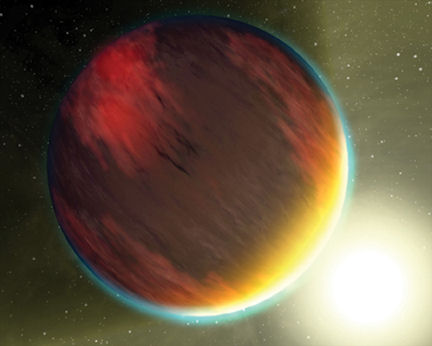Astronomers have for the first time recorded the spectra of light emitted by two extrasolar planets. This achievement provides a new, direct way to analyze the atmosphere of alien worlds light-years from Earth.

Obtained by NASA’s Spitzer Space Telescope, the infrared spectra represent a milestone in the study of distant planets, says David Charbonneau of the Harvard-Smithsonian Center for Astrophysics in Cambridge, Mass. Both planets show a puzzling lack of water vapor, he adds.
Charbonneau and members of two other teams reported the findings during a NASA briefing this week.
Spitzer recorded spectra both when the planets were behind their respective stars and when they passed in front of them, as seen from Earth. For each system, subtracting the spectrum of the star from that of the star and planet together yielded the spectrum of the planet.
Astronomers had previously used a subtraction method to measure the overall infrared glow of two extrasolar planets (SN: 3/26/05, p. 195: Alien Light: Extrasolar planets are detected in new way). Four years earlier, researchers had recorded the intensity of a single wavelength of starlight that filtered through the atmosphere of one of the planets featured in the current reports. That team determined that the planet’s atmosphere has only a low concentration of sodium (SN: 12/1/01, p. 340: Craft Probes Alien Planet’s Atmosphere).
The new findings are the first to analyze, wavelength by wavelength, the infrared radiation, and therefore heat, emitted by extrasolar planets, notes Jeremy Richardson of NASA’s Goddard Space Flight Center in Greenbelt, Md. He and his colleagues examined the hot, Jupiterlike planet HD 209458b about 153 light-years from Earth. They describe their findings in the Feb. 22 Nature.
Another team, led by Mark R. Swain of NASA’s Jet Propulsion Laboratory in Pasadena, Calif., analyzed the same data independently. A third team, which includes Charbonneau, took spectra of another hot Jupiter, the planet HD 189733b, which lies 62 light-years from Earth. Charbonneau and his colleagues describe their findings in an upcoming Astrophysical Journal Letters.
The spectrum of each planet shows no sign of water vapor. That’s surprising, notes theorist Jonathan Fortney of NASA’s Ames Research Center in Mountain View, Calif., because scientists had expected hydrogen and oxygen atoms in the atmospheres of these hot planets to readily combine into water. Water is abundant in the atmosphere of brown dwarfs, or failed stars, which are the bodies most resembling hot Jupiters, he adds.
Richardson’s team, which reports hints of silicates in the atmosphere of HD 209458b, proposes that high-altitude silicate clouds may mask water vapor at lower altitudes. But Swain and his collaborators find no evidence of silicates in the same data, and Charbonneau’s team sees no sign of silicates in the spectra of HD 189733b.
Fortney says that if the atmosphere of the extrasolar planets has the same temperature throughout—unlike the atmospheres of Earth, Saturn, or Jupiter—water vapor or other compounds wouldn’t be evident in the spectrum.
Another possibility, he notes, is that intense ultraviolet light bombarding the close-in planets from their stars generates high-altitude clouds of unknown composition. Those clouds would absorb infrared light over a wide range of wavelengths and mask underlying water vapor and other molecules. Sodium in the atmosphere of HD 209458b might also be obscured by such clouds, Fortney says.
Additional Spitzer observations of the planets, Swain says, should solve the mystery of the missing water vapor.







